Analysis of Financial Statements: Assumptions, Stakeholders, and Uses
VerifiedAdded on 2022/09/21
|10
|2247
|21
Report
AI Summary
This report provides a comprehensive analysis of financial statements, delving into the core accounting assumptions that underpin their preparation. It examines the accrual assumption, conservatism, consistency, economic entity, going concern, reliability, and time period assumptions, explaining their significance and implications. Furthermore, the report explores how various stakeholders, including investors, employees, lenders, government, suppliers, customers, and society, utilize financial statements to make informed decisions. It highlights the specific information each stakeholder seeks and how they interpret the financial data to assess a company's performance, financial health, and future prospects. The report references several academic sources to support its analysis and provide a well-rounded understanding of financial statement analysis.
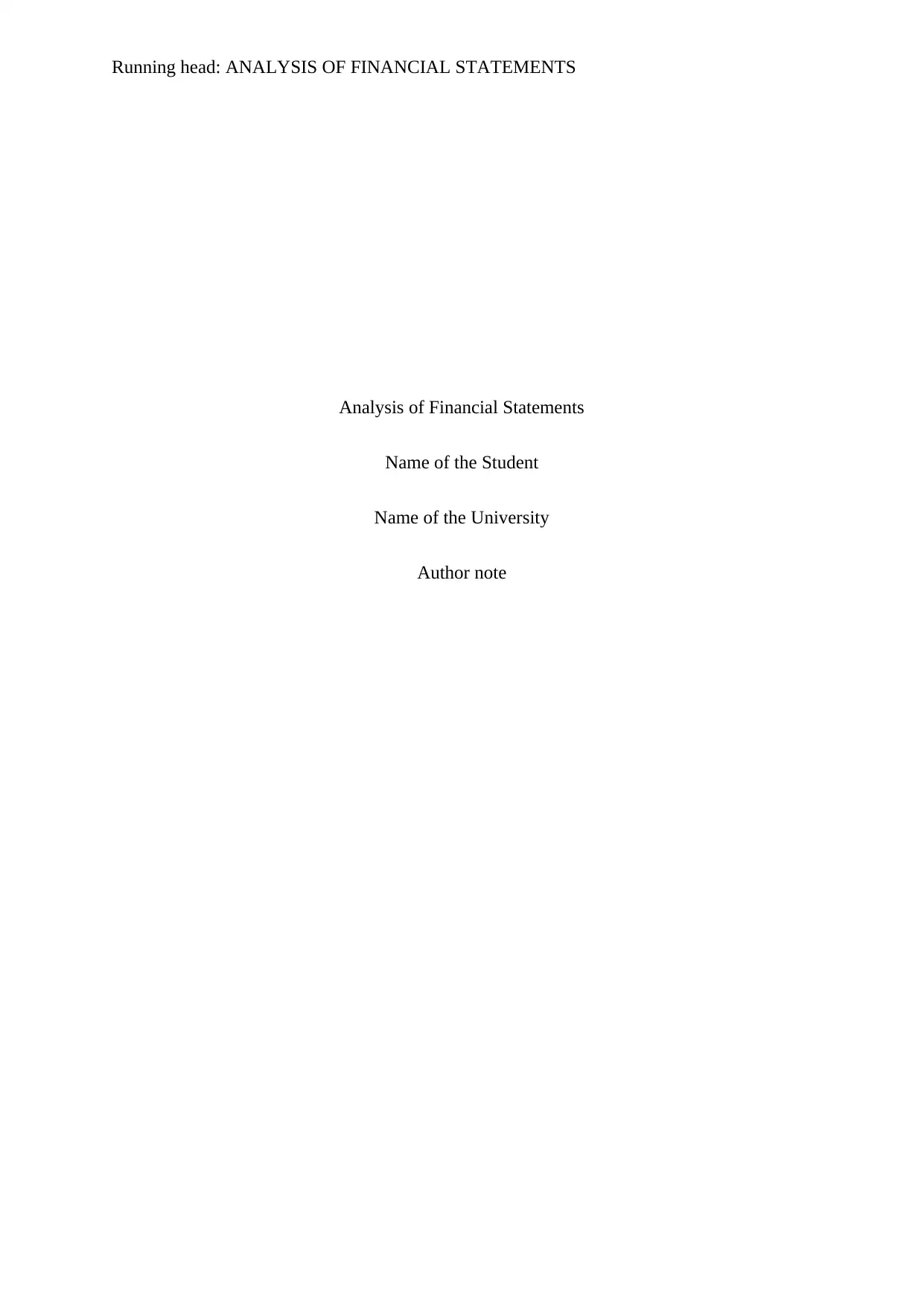
Running head: ANALYSIS OF FINANCIAL STATEMENTS
Analysis of Financial Statements
Name of the Student
Name of the University
Author note
Analysis of Financial Statements
Name of the Student
Name of the University
Author note
Paraphrase This Document
Need a fresh take? Get an instant paraphrase of this document with our AI Paraphraser
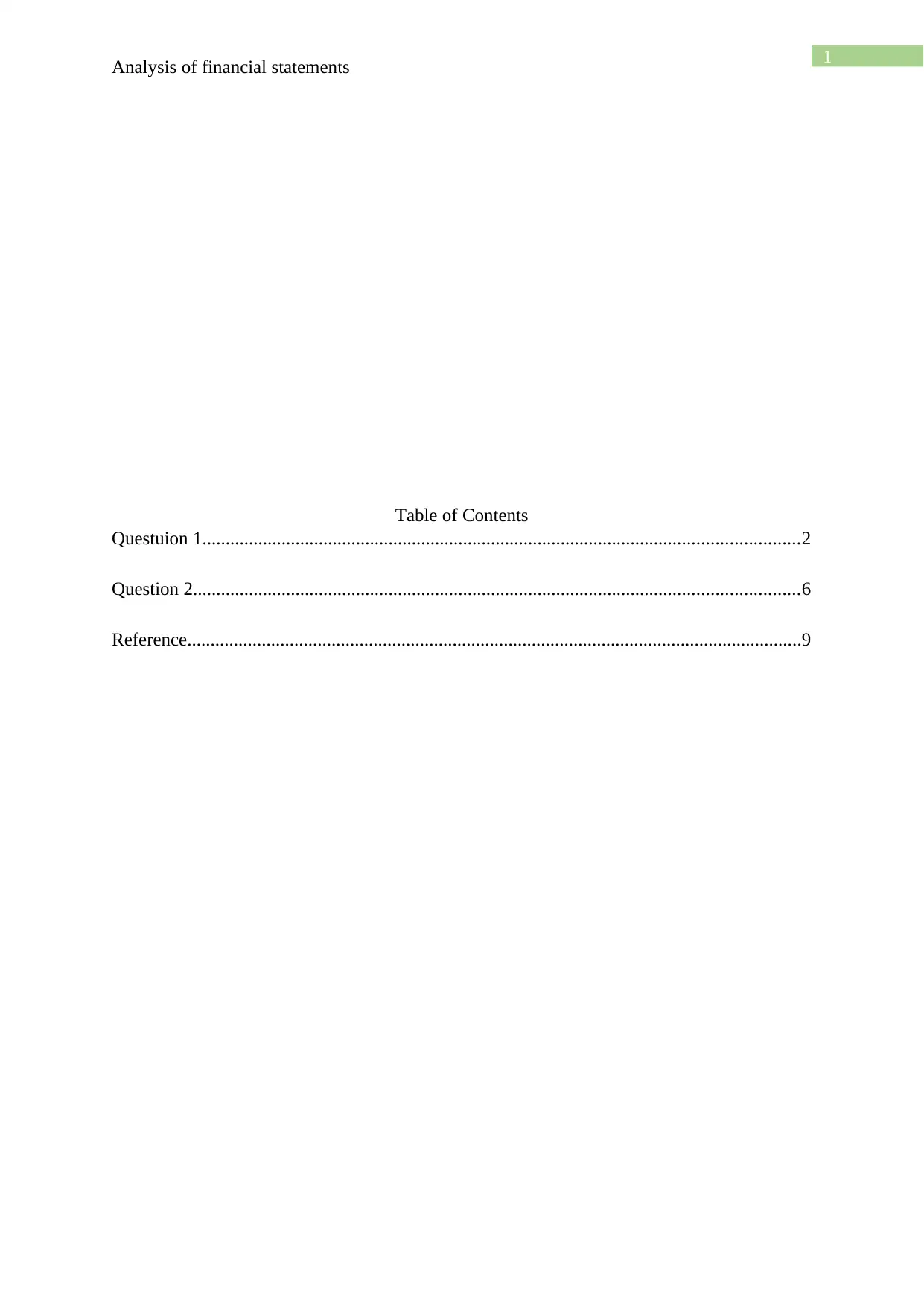
1
Analysis of financial statements
Table of Contents
Questuion 1................................................................................................................................2
Question 2..................................................................................................................................6
Reference....................................................................................................................................9
Analysis of financial statements
Table of Contents
Questuion 1................................................................................................................................2
Question 2..................................................................................................................................6
Reference....................................................................................................................................9
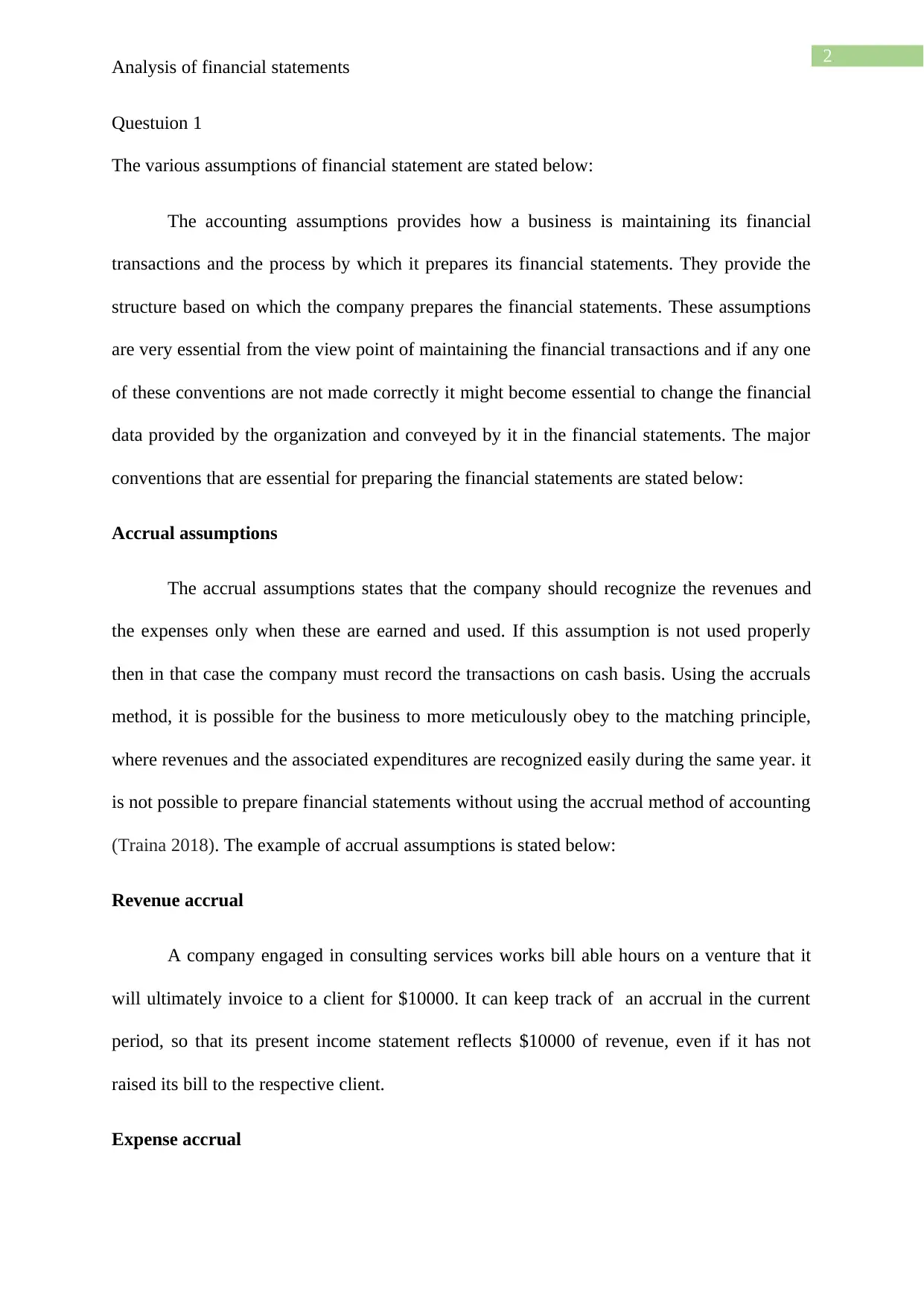
2
Analysis of financial statements
Questuion 1
The various assumptions of financial statement are stated below:
The accounting assumptions provides how a business is maintaining its financial
transactions and the process by which it prepares its financial statements. They provide the
structure based on which the company prepares the financial statements. These assumptions
are very essential from the view point of maintaining the financial transactions and if any one
of these conventions are not made correctly it might become essential to change the financial
data provided by the organization and conveyed by it in the financial statements. The major
conventions that are essential for preparing the financial statements are stated below:
Accrual assumptions
The accrual assumptions states that the company should recognize the revenues and
the expenses only when these are earned and used. If this assumption is not used properly
then in that case the company must record the transactions on cash basis. Using the accruals
method, it is possible for the business to more meticulously obey to the matching principle,
where revenues and the associated expenditures are recognized easily during the same year. it
is not possible to prepare financial statements without using the accrual method of accounting
(Traina 2018). The example of accrual assumptions is stated below:
Revenue accrual
A company engaged in consulting services works bill able hours on a venture that it
will ultimately invoice to a client for $10000. It can keep track of an accrual in the current
period, so that its present income statement reflects $10000 of revenue, even if it has not
raised its bill to the respective client.
Expense accrual
Analysis of financial statements
Questuion 1
The various assumptions of financial statement are stated below:
The accounting assumptions provides how a business is maintaining its financial
transactions and the process by which it prepares its financial statements. They provide the
structure based on which the company prepares the financial statements. These assumptions
are very essential from the view point of maintaining the financial transactions and if any one
of these conventions are not made correctly it might become essential to change the financial
data provided by the organization and conveyed by it in the financial statements. The major
conventions that are essential for preparing the financial statements are stated below:
Accrual assumptions
The accrual assumptions states that the company should recognize the revenues and
the expenses only when these are earned and used. If this assumption is not used properly
then in that case the company must record the transactions on cash basis. Using the accruals
method, it is possible for the business to more meticulously obey to the matching principle,
where revenues and the associated expenditures are recognized easily during the same year. it
is not possible to prepare financial statements without using the accrual method of accounting
(Traina 2018). The example of accrual assumptions is stated below:
Revenue accrual
A company engaged in consulting services works bill able hours on a venture that it
will ultimately invoice to a client for $10000. It can keep track of an accrual in the current
period, so that its present income statement reflects $10000 of revenue, even if it has not
raised its bill to the respective client.
Expense accrual
⊘ This is a preview!⊘
Do you want full access?
Subscribe today to unlock all pages.

Trusted by 1+ million students worldwide
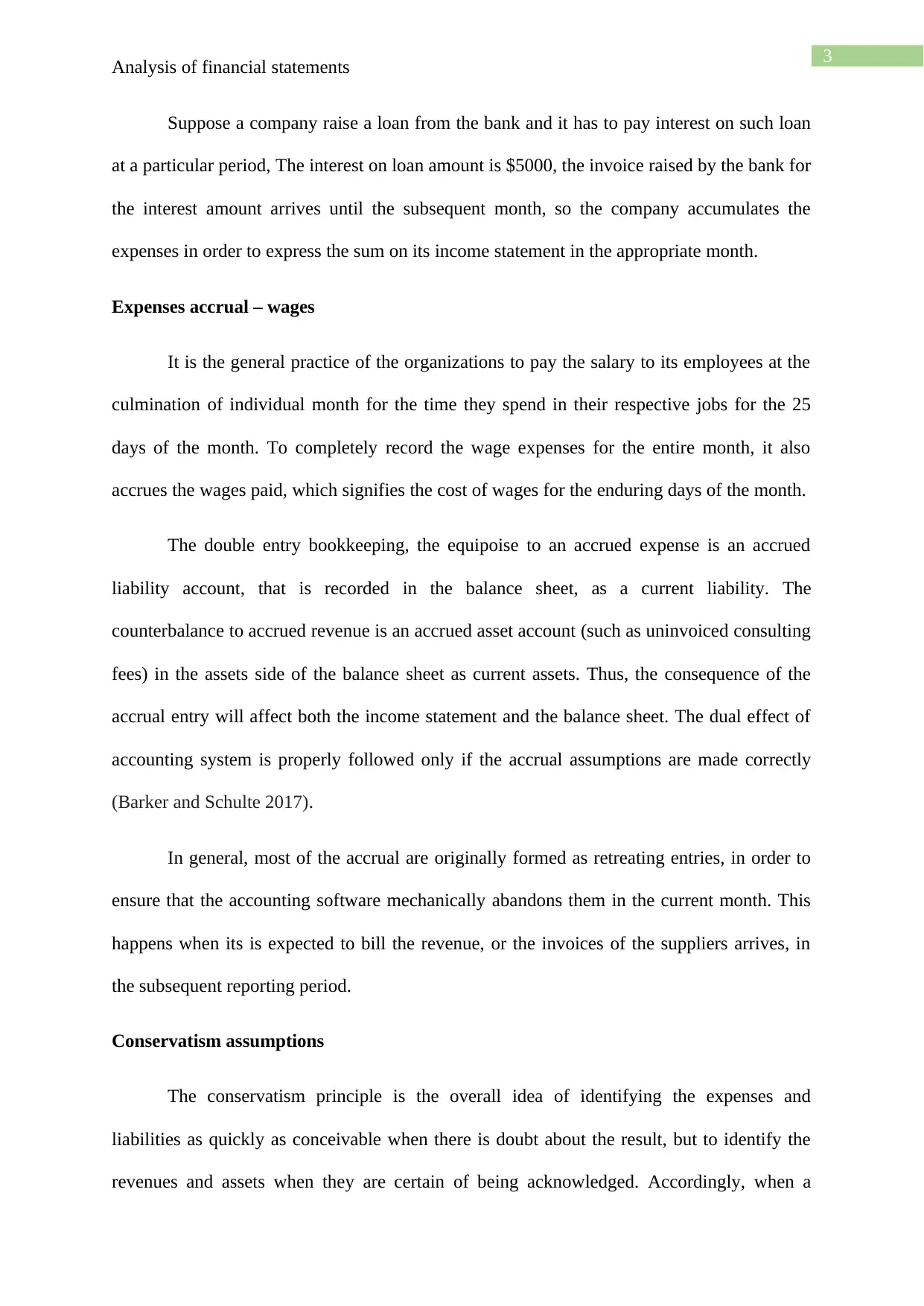
3
Analysis of financial statements
Suppose a company raise a loan from the bank and it has to pay interest on such loan
at a particular period, The interest on loan amount is $5000, the invoice raised by the bank for
the interest amount arrives until the subsequent month, so the company accumulates the
expenses in order to express the sum on its income statement in the appropriate month.
Expenses accrual – wages
It is the general practice of the organizations to pay the salary to its employees at the
culmination of individual month for the time they spend in their respective jobs for the 25
days of the month. To completely record the wage expenses for the entire month, it also
accrues the wages paid, which signifies the cost of wages for the enduring days of the month.
The double entry bookkeeping, the equipoise to an accrued expense is an accrued
liability account, that is recorded in the balance sheet, as a current liability. The
counterbalance to accrued revenue is an accrued asset account (such as uninvoiced consulting
fees) in the assets side of the balance sheet as current assets. Thus, the consequence of the
accrual entry will affect both the income statement and the balance sheet. The dual effect of
accounting system is properly followed only if the accrual assumptions are made correctly
(Barker and Schulte 2017).
In general, most of the accrual are originally formed as retreating entries, in order to
ensure that the accounting software mechanically abandons them in the current month. This
happens when its is expected to bill the revenue, or the invoices of the suppliers arrives, in
the subsequent reporting period.
Conservatism assumptions
The conservatism principle is the overall idea of identifying the expenses and
liabilities as quickly as conceivable when there is doubt about the result, but to identify the
revenues and assets when they are certain of being acknowledged. Accordingly, when a
Analysis of financial statements
Suppose a company raise a loan from the bank and it has to pay interest on such loan
at a particular period, The interest on loan amount is $5000, the invoice raised by the bank for
the interest amount arrives until the subsequent month, so the company accumulates the
expenses in order to express the sum on its income statement in the appropriate month.
Expenses accrual – wages
It is the general practice of the organizations to pay the salary to its employees at the
culmination of individual month for the time they spend in their respective jobs for the 25
days of the month. To completely record the wage expenses for the entire month, it also
accrues the wages paid, which signifies the cost of wages for the enduring days of the month.
The double entry bookkeeping, the equipoise to an accrued expense is an accrued
liability account, that is recorded in the balance sheet, as a current liability. The
counterbalance to accrued revenue is an accrued asset account (such as uninvoiced consulting
fees) in the assets side of the balance sheet as current assets. Thus, the consequence of the
accrual entry will affect both the income statement and the balance sheet. The dual effect of
accounting system is properly followed only if the accrual assumptions are made correctly
(Barker and Schulte 2017).
In general, most of the accrual are originally formed as retreating entries, in order to
ensure that the accounting software mechanically abandons them in the current month. This
happens when its is expected to bill the revenue, or the invoices of the suppliers arrives, in
the subsequent reporting period.
Conservatism assumptions
The conservatism principle is the overall idea of identifying the expenses and
liabilities as quickly as conceivable when there is doubt about the result, but to identify the
revenues and assets when they are certain of being acknowledged. Accordingly, when a
Paraphrase This Document
Need a fresh take? Get an instant paraphrase of this document with our AI Paraphraser
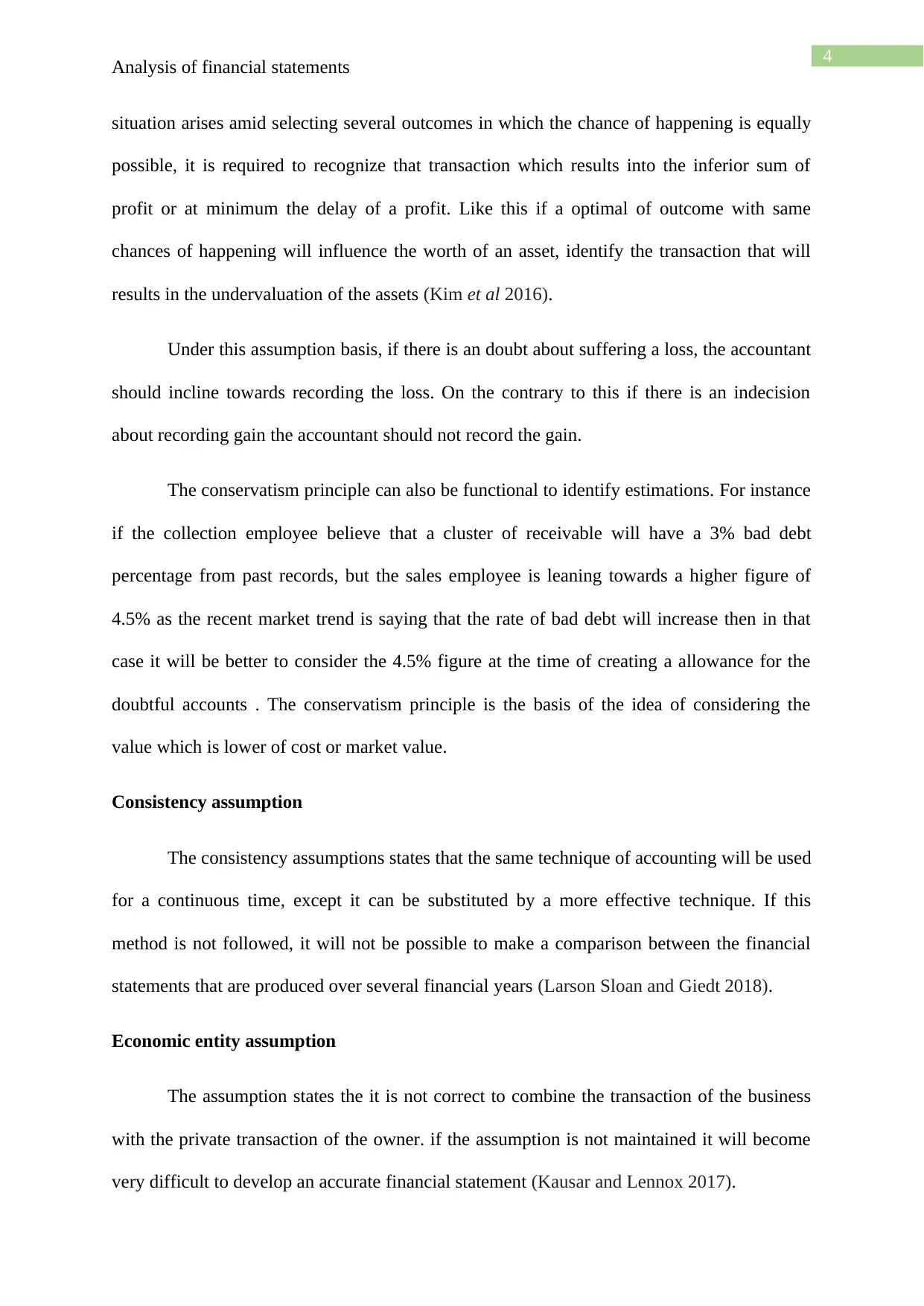
4
Analysis of financial statements
situation arises amid selecting several outcomes in which the chance of happening is equally
possible, it is required to recognize that transaction which results into the inferior sum of
profit or at minimum the delay of a profit. Like this if a optimal of outcome with same
chances of happening will influence the worth of an asset, identify the transaction that will
results in the undervaluation of the assets (Kim et al 2016).
Under this assumption basis, if there is an doubt about suffering a loss, the accountant
should incline towards recording the loss. On the contrary to this if there is an indecision
about recording gain the accountant should not record the gain.
The conservatism principle can also be functional to identify estimations. For instance
if the collection employee believe that a cluster of receivable will have a 3% bad debt
percentage from past records, but the sales employee is leaning towards a higher figure of
4.5% as the recent market trend is saying that the rate of bad debt will increase then in that
case it will be better to consider the 4.5% figure at the time of creating a allowance for the
doubtful accounts . The conservatism principle is the basis of the idea of considering the
value which is lower of cost or market value.
Consistency assumption
The consistency assumptions states that the same technique of accounting will be used
for a continuous time, except it can be substituted by a more effective technique. If this
method is not followed, it will not be possible to make a comparison between the financial
statements that are produced over several financial years (Larson Sloan and Giedt 2018).
Economic entity assumption
The assumption states the it is not correct to combine the transaction of the business
with the private transaction of the owner. if the assumption is not maintained it will become
very difficult to develop an accurate financial statement (Kausar and Lennox 2017).
Analysis of financial statements
situation arises amid selecting several outcomes in which the chance of happening is equally
possible, it is required to recognize that transaction which results into the inferior sum of
profit or at minimum the delay of a profit. Like this if a optimal of outcome with same
chances of happening will influence the worth of an asset, identify the transaction that will
results in the undervaluation of the assets (Kim et al 2016).
Under this assumption basis, if there is an doubt about suffering a loss, the accountant
should incline towards recording the loss. On the contrary to this if there is an indecision
about recording gain the accountant should not record the gain.
The conservatism principle can also be functional to identify estimations. For instance
if the collection employee believe that a cluster of receivable will have a 3% bad debt
percentage from past records, but the sales employee is leaning towards a higher figure of
4.5% as the recent market trend is saying that the rate of bad debt will increase then in that
case it will be better to consider the 4.5% figure at the time of creating a allowance for the
doubtful accounts . The conservatism principle is the basis of the idea of considering the
value which is lower of cost or market value.
Consistency assumption
The consistency assumptions states that the same technique of accounting will be used
for a continuous time, except it can be substituted by a more effective technique. If this
method is not followed, it will not be possible to make a comparison between the financial
statements that are produced over several financial years (Larson Sloan and Giedt 2018).
Economic entity assumption
The assumption states the it is not correct to combine the transaction of the business
with the private transaction of the owner. if the assumption is not maintained it will become
very difficult to develop an accurate financial statement (Kausar and Lennox 2017).
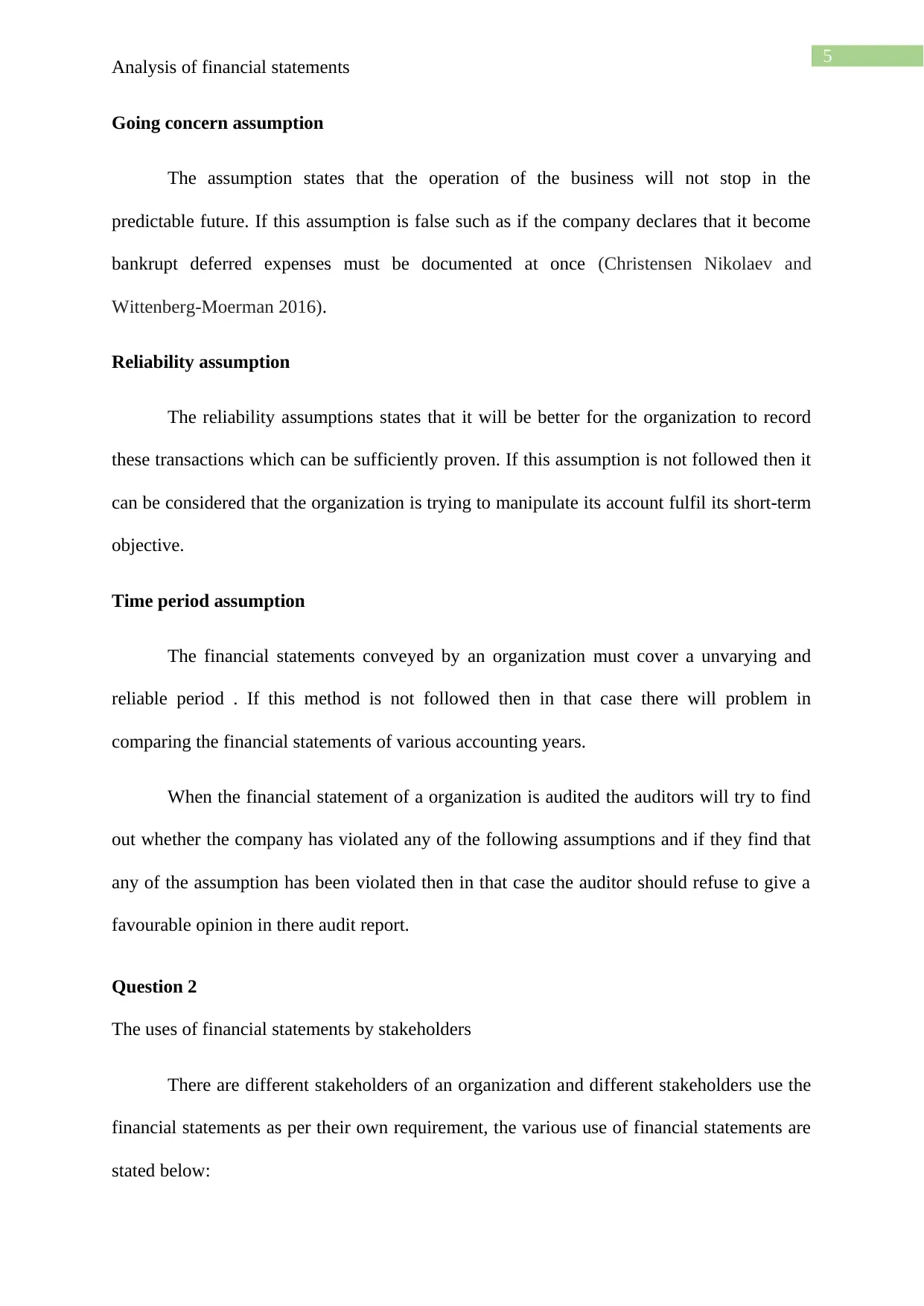
5
Analysis of financial statements
Going concern assumption
The assumption states that the operation of the business will not stop in the
predictable future. If this assumption is false such as if the company declares that it become
bankrupt deferred expenses must be documented at once (Christensen Nikolaev and
Wittenberg‐Moerman 2016).
Reliability assumption
The reliability assumptions states that it will be better for the organization to record
these transactions which can be sufficiently proven. If this assumption is not followed then it
can be considered that the organization is trying to manipulate its account fulfil its short-term
objective.
Time period assumption
The financial statements conveyed by an organization must cover a unvarying and
reliable period . If this method is not followed then in that case there will problem in
comparing the financial statements of various accounting years.
When the financial statement of a organization is audited the auditors will try to find
out whether the company has violated any of the following assumptions and if they find that
any of the assumption has been violated then in that case the auditor should refuse to give a
favourable opinion in there audit report.
Question 2
The uses of financial statements by stakeholders
There are different stakeholders of an organization and different stakeholders use the
financial statements as per their own requirement, the various use of financial statements are
stated below:
Analysis of financial statements
Going concern assumption
The assumption states that the operation of the business will not stop in the
predictable future. If this assumption is false such as if the company declares that it become
bankrupt deferred expenses must be documented at once (Christensen Nikolaev and
Wittenberg‐Moerman 2016).
Reliability assumption
The reliability assumptions states that it will be better for the organization to record
these transactions which can be sufficiently proven. If this assumption is not followed then it
can be considered that the organization is trying to manipulate its account fulfil its short-term
objective.
Time period assumption
The financial statements conveyed by an organization must cover a unvarying and
reliable period . If this method is not followed then in that case there will problem in
comparing the financial statements of various accounting years.
When the financial statement of a organization is audited the auditors will try to find
out whether the company has violated any of the following assumptions and if they find that
any of the assumption has been violated then in that case the auditor should refuse to give a
favourable opinion in there audit report.
Question 2
The uses of financial statements by stakeholders
There are different stakeholders of an organization and different stakeholders use the
financial statements as per their own requirement, the various use of financial statements are
stated below:
⊘ This is a preview!⊘
Do you want full access?
Subscribe today to unlock all pages.

Trusted by 1+ million students worldwide
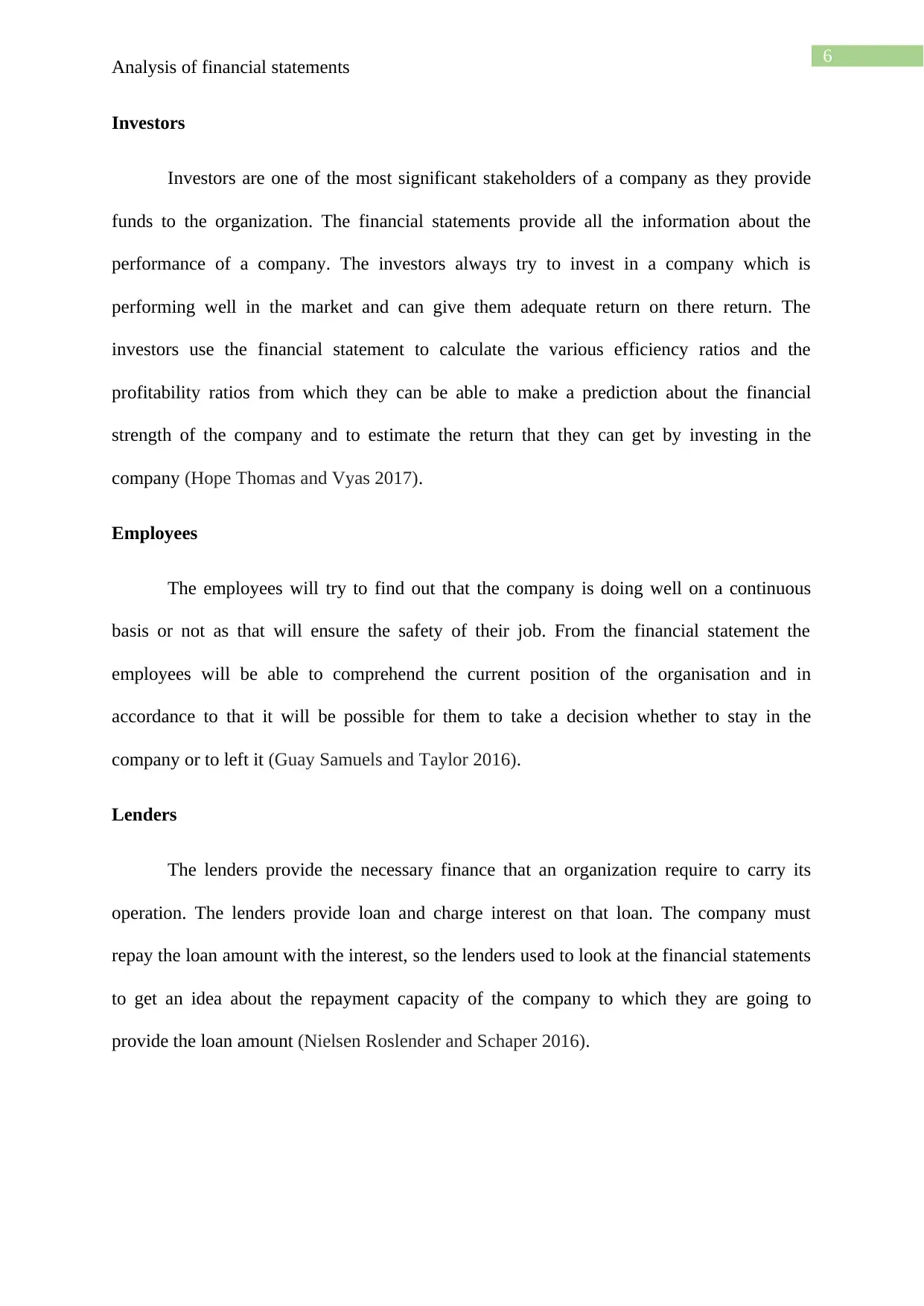
6
Analysis of financial statements
Investors
Investors are one of the most significant stakeholders of a company as they provide
funds to the organization. The financial statements provide all the information about the
performance of a company. The investors always try to invest in a company which is
performing well in the market and can give them adequate return on there return. The
investors use the financial statement to calculate the various efficiency ratios and the
profitability ratios from which they can be able to make a prediction about the financial
strength of the company and to estimate the return that they can get by investing in the
company (Hope Thomas and Vyas 2017).
Employees
The employees will try to find out that the company is doing well on a continuous
basis or not as that will ensure the safety of their job. From the financial statement the
employees will be able to comprehend the current position of the organisation and in
accordance to that it will be possible for them to take a decision whether to stay in the
company or to left it (Guay Samuels and Taylor 2016).
Lenders
The lenders provide the necessary finance that an organization require to carry its
operation. The lenders provide loan and charge interest on that loan. The company must
repay the loan amount with the interest, so the lenders used to look at the financial statements
to get an idea about the repayment capacity of the company to which they are going to
provide the loan amount (Nielsen Roslender and Schaper 2016).
Analysis of financial statements
Investors
Investors are one of the most significant stakeholders of a company as they provide
funds to the organization. The financial statements provide all the information about the
performance of a company. The investors always try to invest in a company which is
performing well in the market and can give them adequate return on there return. The
investors use the financial statement to calculate the various efficiency ratios and the
profitability ratios from which they can be able to make a prediction about the financial
strength of the company and to estimate the return that they can get by investing in the
company (Hope Thomas and Vyas 2017).
Employees
The employees will try to find out that the company is doing well on a continuous
basis or not as that will ensure the safety of their job. From the financial statement the
employees will be able to comprehend the current position of the organisation and in
accordance to that it will be possible for them to take a decision whether to stay in the
company or to left it (Guay Samuels and Taylor 2016).
Lenders
The lenders provide the necessary finance that an organization require to carry its
operation. The lenders provide loan and charge interest on that loan. The company must
repay the loan amount with the interest, so the lenders used to look at the financial statements
to get an idea about the repayment capacity of the company to which they are going to
provide the loan amount (Nielsen Roslender and Schaper 2016).
Paraphrase This Document
Need a fresh take? Get an instant paraphrase of this document with our AI Paraphraser
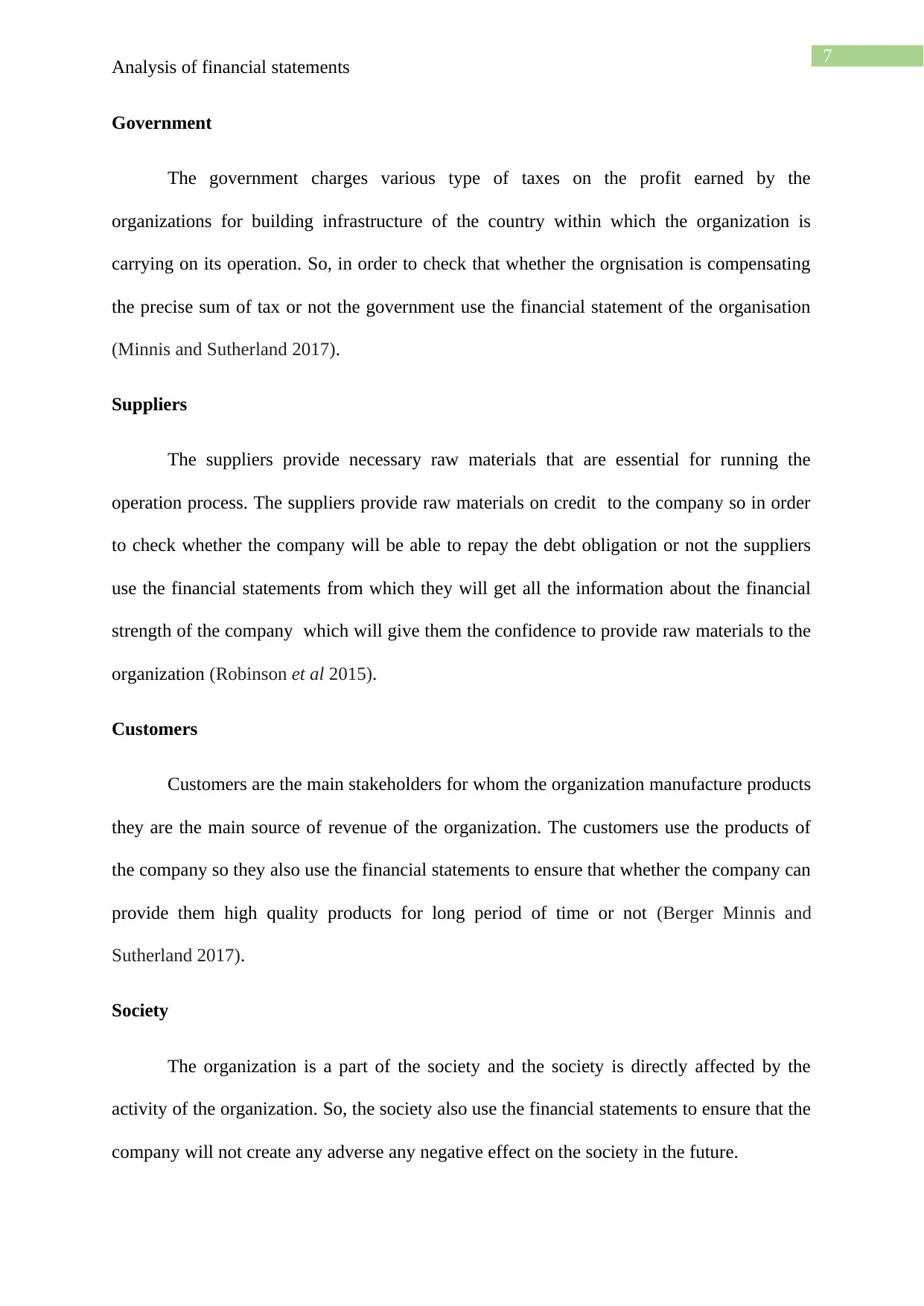
7
Analysis of financial statements
Government
The government charges various type of taxes on the profit earned by the
organizations for building infrastructure of the country within which the organization is
carrying on its operation. So, in order to check that whether the orgnisation is compensating
the precise sum of tax or not the government use the financial statement of the organisation
(Minnis and Sutherland 2017).
Suppliers
The suppliers provide necessary raw materials that are essential for running the
operation process. The suppliers provide raw materials on credit to the company so in order
to check whether the company will be able to repay the debt obligation or not the suppliers
use the financial statements from which they will get all the information about the financial
strength of the company which will give them the confidence to provide raw materials to the
organization (Robinson et al 2015).
Customers
Customers are the main stakeholders for whom the organization manufacture products
they are the main source of revenue of the organization. The customers use the products of
the company so they also use the financial statements to ensure that whether the company can
provide them high quality products for long period of time or not (Berger Minnis and
Sutherland 2017).
Society
The organization is a part of the society and the society is directly affected by the
activity of the organization. So, the society also use the financial statements to ensure that the
company will not create any adverse any negative effect on the society in the future.
Analysis of financial statements
Government
The government charges various type of taxes on the profit earned by the
organizations for building infrastructure of the country within which the organization is
carrying on its operation. So, in order to check that whether the orgnisation is compensating
the precise sum of tax or not the government use the financial statement of the organisation
(Minnis and Sutherland 2017).
Suppliers
The suppliers provide necessary raw materials that are essential for running the
operation process. The suppliers provide raw materials on credit to the company so in order
to check whether the company will be able to repay the debt obligation or not the suppliers
use the financial statements from which they will get all the information about the financial
strength of the company which will give them the confidence to provide raw materials to the
organization (Robinson et al 2015).
Customers
Customers are the main stakeholders for whom the organization manufacture products
they are the main source of revenue of the organization. The customers use the products of
the company so they also use the financial statements to ensure that whether the company can
provide them high quality products for long period of time or not (Berger Minnis and
Sutherland 2017).
Society
The organization is a part of the society and the society is directly affected by the
activity of the organization. So, the society also use the financial statements to ensure that the
company will not create any adverse any negative effect on the society in the future.
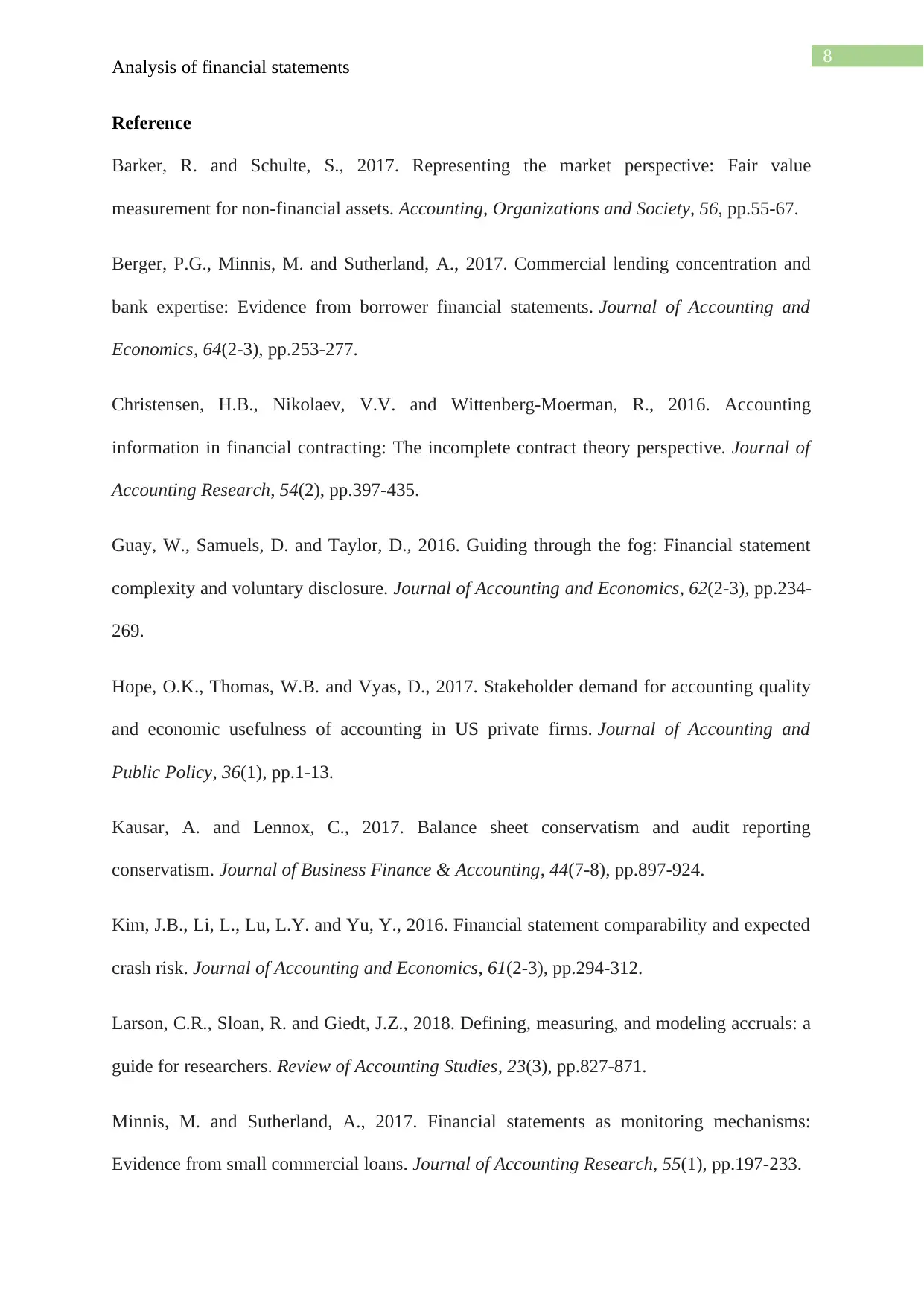
8
Analysis of financial statements
Reference
Barker, R. and Schulte, S., 2017. Representing the market perspective: Fair value
measurement for non-financial assets. Accounting, Organizations and Society, 56, pp.55-67.
Berger, P.G., Minnis, M. and Sutherland, A., 2017. Commercial lending concentration and
bank expertise: Evidence from borrower financial statements. Journal of Accounting and
Economics, 64(2-3), pp.253-277.
Christensen, H.B., Nikolaev, V.V. and Wittenberg‐Moerman, R., 2016. Accounting
information in financial contracting: The incomplete contract theory perspective. Journal of
Accounting Research, 54(2), pp.397-435.
Guay, W., Samuels, D. and Taylor, D., 2016. Guiding through the fog: Financial statement
complexity and voluntary disclosure. Journal of Accounting and Economics, 62(2-3), pp.234-
269.
Hope, O.K., Thomas, W.B. and Vyas, D., 2017. Stakeholder demand for accounting quality
and economic usefulness of accounting in US private firms. Journal of Accounting and
Public Policy, 36(1), pp.1-13.
Kausar, A. and Lennox, C., 2017. Balance sheet conservatism and audit reporting
conservatism. Journal of Business Finance & Accounting, 44(7-8), pp.897-924.
Kim, J.B., Li, L., Lu, L.Y. and Yu, Y., 2016. Financial statement comparability and expected
crash risk. Journal of Accounting and Economics, 61(2-3), pp.294-312.
Larson, C.R., Sloan, R. and Giedt, J.Z., 2018. Defining, measuring, and modeling accruals: a
guide for researchers. Review of Accounting Studies, 23(3), pp.827-871.
Minnis, M. and Sutherland, A., 2017. Financial statements as monitoring mechanisms:
Evidence from small commercial loans. Journal of Accounting Research, 55(1), pp.197-233.
Analysis of financial statements
Reference
Barker, R. and Schulte, S., 2017. Representing the market perspective: Fair value
measurement for non-financial assets. Accounting, Organizations and Society, 56, pp.55-67.
Berger, P.G., Minnis, M. and Sutherland, A., 2017. Commercial lending concentration and
bank expertise: Evidence from borrower financial statements. Journal of Accounting and
Economics, 64(2-3), pp.253-277.
Christensen, H.B., Nikolaev, V.V. and Wittenberg‐Moerman, R., 2016. Accounting
information in financial contracting: The incomplete contract theory perspective. Journal of
Accounting Research, 54(2), pp.397-435.
Guay, W., Samuels, D. and Taylor, D., 2016. Guiding through the fog: Financial statement
complexity and voluntary disclosure. Journal of Accounting and Economics, 62(2-3), pp.234-
269.
Hope, O.K., Thomas, W.B. and Vyas, D., 2017. Stakeholder demand for accounting quality
and economic usefulness of accounting in US private firms. Journal of Accounting and
Public Policy, 36(1), pp.1-13.
Kausar, A. and Lennox, C., 2017. Balance sheet conservatism and audit reporting
conservatism. Journal of Business Finance & Accounting, 44(7-8), pp.897-924.
Kim, J.B., Li, L., Lu, L.Y. and Yu, Y., 2016. Financial statement comparability and expected
crash risk. Journal of Accounting and Economics, 61(2-3), pp.294-312.
Larson, C.R., Sloan, R. and Giedt, J.Z., 2018. Defining, measuring, and modeling accruals: a
guide for researchers. Review of Accounting Studies, 23(3), pp.827-871.
Minnis, M. and Sutherland, A., 2017. Financial statements as monitoring mechanisms:
Evidence from small commercial loans. Journal of Accounting Research, 55(1), pp.197-233.
⊘ This is a preview!⊘
Do you want full access?
Subscribe today to unlock all pages.

Trusted by 1+ million students worldwide
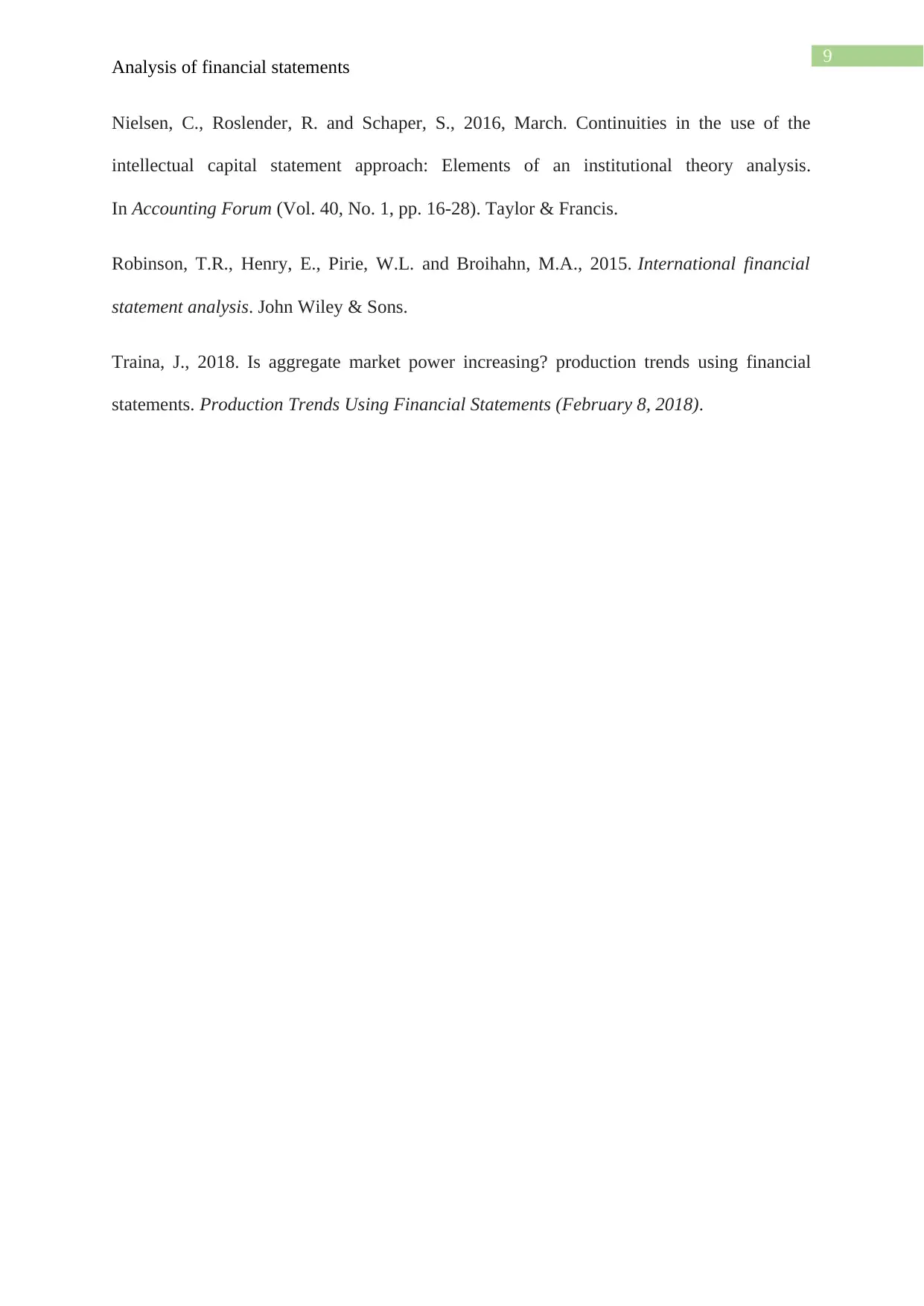
9
Analysis of financial statements
Nielsen, C., Roslender, R. and Schaper, S., 2016, March. Continuities in the use of the
intellectual capital statement approach: Elements of an institutional theory analysis.
In Accounting Forum (Vol. 40, No. 1, pp. 16-28). Taylor & Francis.
Robinson, T.R., Henry, E., Pirie, W.L. and Broihahn, M.A., 2015. International financial
statement analysis. John Wiley & Sons.
Traina, J., 2018. Is aggregate market power increasing? production trends using financial
statements. Production Trends Using Financial Statements (February 8, 2018).
Analysis of financial statements
Nielsen, C., Roslender, R. and Schaper, S., 2016, March. Continuities in the use of the
intellectual capital statement approach: Elements of an institutional theory analysis.
In Accounting Forum (Vol. 40, No. 1, pp. 16-28). Taylor & Francis.
Robinson, T.R., Henry, E., Pirie, W.L. and Broihahn, M.A., 2015. International financial
statement analysis. John Wiley & Sons.
Traina, J., 2018. Is aggregate market power increasing? production trends using financial
statements. Production Trends Using Financial Statements (February 8, 2018).
1 out of 10
Related Documents
Your All-in-One AI-Powered Toolkit for Academic Success.
+13062052269
info@desklib.com
Available 24*7 on WhatsApp / Email
![[object Object]](/_next/static/media/star-bottom.7253800d.svg)
Unlock your academic potential
Copyright © 2020–2025 A2Z Services. All Rights Reserved. Developed and managed by ZUCOL.





